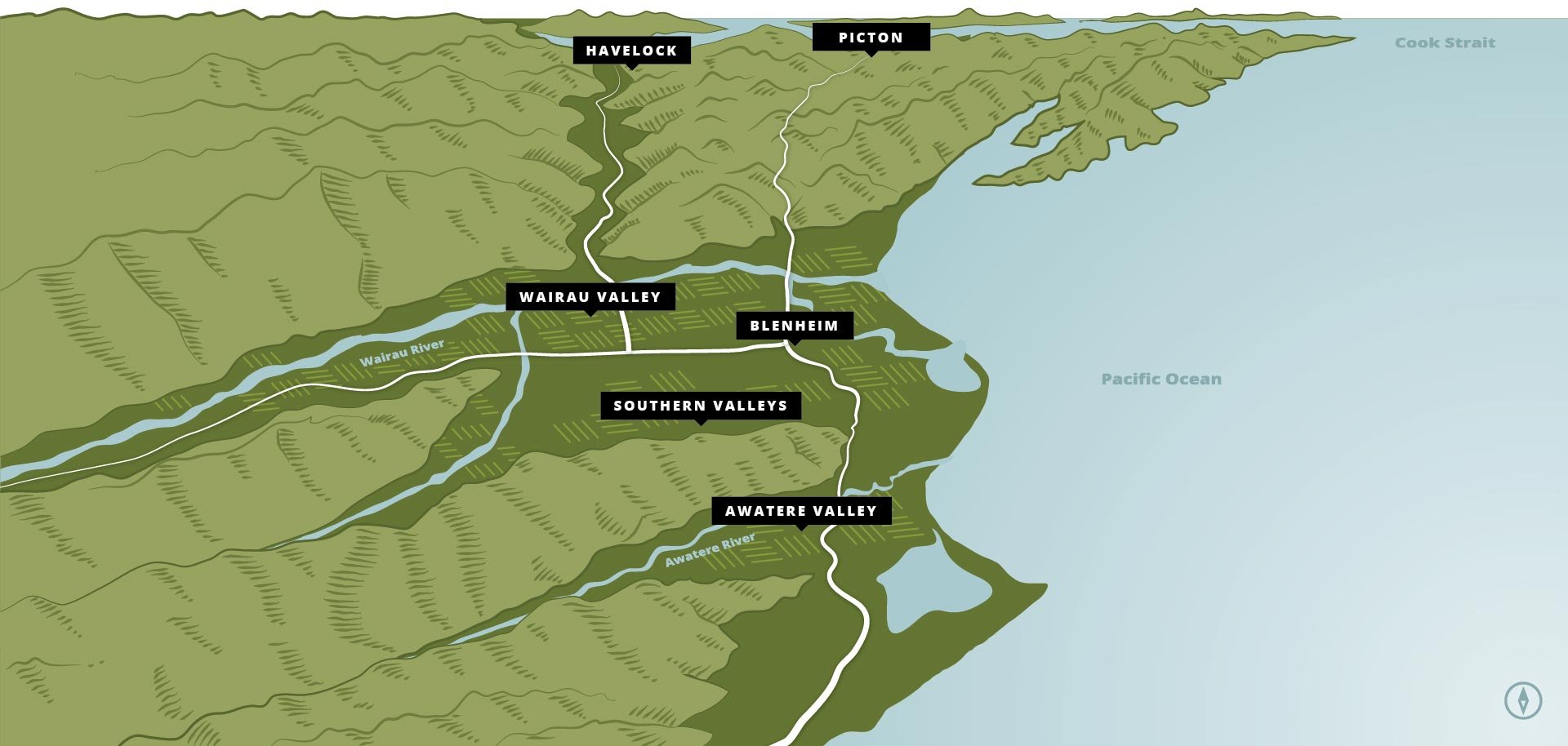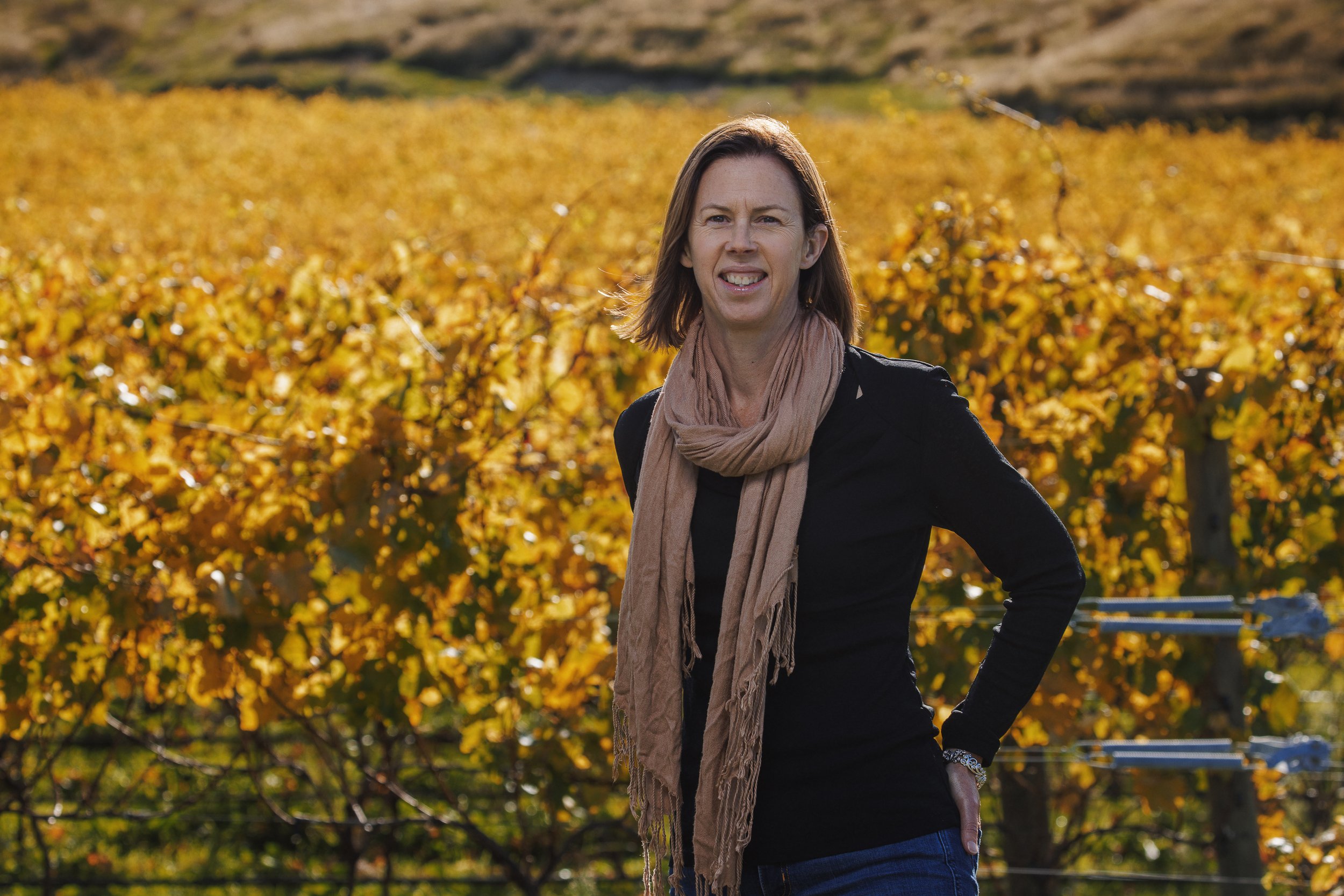Climate & ViticultureWe are cradled by protective mountain ranges and the fresh coastal breezes of the Pacific Ocean. We respect our duty to guard our place, just as our place guards us.
Sustainability is an integral part of the New Zealand wine industry. Sustainable Winegrowing NZ™ is widely recognised as a world-leading sustainability programme. As of today, 97% percent of Marlborough’s producing vineyard area is certified by SWNZ.
Image: NZW, Churton
ClimateSituated at the top of New Zealand’s South Island, with Cook Strait to the north and the Pacific Ocean to the east, Marlborough experiences a maritime climate. This provides a cooling influence which, coupled with some of the highest sunshine hours in the country, creates the perfect environment for grape growing.
Hot days and cooler nights add to the complexity of fruit grown in Marlborough, and the diurnal range of around 11 degrees during summer keeps acid levels high over long ripening times creating piercing fruit intensity and strong varietal expression. The eastern coastal aspect bestows cooling sea breezes and protective mountains give relief from extreme rain and wind. Long Indian summers occasionally dice with drought but more often allow a wide range of styles to flourish.
-
Collection and collation of Met data is funded by the Marlborough Research Centre. Weather reports and growing degree day data can be found here.
Winepress Magazine publishes a monthly met report written by Rob Agnew from Plant & Food Research. All past issues can be found here.
-
VineFacts is an annual growing season update published by New Zealand Winegrowers that assists members by providing weekly weather data summaries for each region and seasonal phenology comparisons. To access please email vinefacts@nzwine.com.
Image: NZW, Whitehaven
2,409
AVERAGE ANNUAL SUNSHINE (HOURS)
655
AVERAGE ANNUAL RAINFALL (mm)
Image: NZW, Rapaura Springs Blind River Vineyard
ViticulturePerfectly positioned at 41.3°S, a latitudinal mid-point within the world's wine belt, Marlborough lies on a comparable latitude to many of the world’s longest established wine regions. But its unique maritime climate and significant diurnal temperature variation slows the development of sugars, preserves the natural acidity in the grapes and gives rise to the extraordinarily intense varietal characters for which Marlborough wines are renowned.
We are committed to world-class sustainability and protecting / improving Marlborough, our home and our quality wines. That is why 97% percent of Marlborough’s producing vineyard area is certified by Sustainable Winegrowing NZ™ - a widely recognised world-leading sustainability programme. The perfect pairing for our world-class wine.
This cycle of mutual care, respect and stewardship creates the perfect conditions for wine worthy of the top shelf, of sharing with the people you care about most.
Our natural environment is a significant force in our wine. Our place is a perfect nexus of the most ideal wine-growing conditions. It offers the purest of environments made of young soils and unique climate conditions that have helped not only earn our Sauvignon Blanc’s place on the global stage, but also to create other varieties worthy of the same recognition - that share the quality and palpable sense of place.
In every bottle, you are transported to the place where the grapes were meticulously nurtured, picked and crafted into wine. Where you can take your time to luxuriate in a place that envelops you in the perfect balance between sun and cool fresh air, of breeze and tranquility, of minerality and zesty fruitiness. Where things are encouraged to happen within their own time. This is what makes a Marlborough wine different. It’s a bottled feeling that welcomes you into the region and encourages you to linger a while.
29,654
TOTAL PRODUCING HECTARES
71% of the total producing area of New Zealand
393,865
TOTAL PRODUCTION TONNES
Estimated production NZW 2023 Vintage Survey
78.6%
PROPORTION OF TOTAL NZ HARVEST (2023)

SubregionsMarlborough’s natural environment is a significant factor in the success of our wines. We have three main grape-growing regions – Wairau Valley, the Southern Valleys and Awatere and Southern Marlborough.
Wairau Valley
"Wairau" is a Māori word meaning "many waters". This subregion is broadly defined by its proximity to the 170km long Wairau River that runs from the mountains in the west to the ocean at Cloudy Bay. Marlborough's earliest vineyards were established on the characteristically alluvial river plains that include the acclaimed Rapaura and Renwick areas.
The Wairau sits closer to the Richmond Ranges which see more rainfall than the Wither Hill range that dominates the Southern Valley. It is these ranges that protect the Wairau Valley and Marlborough from weather events coming from the north and north west. Old riverbed and riverbank soils, diverse aspect and rainfall give many meso-climates within this subregion. Broadly, it covers cooler, drier inland sites, barren stony, early ripening sites to sea breeze moderated coastal sites. Soils are more gravelly to the north nearer the riverbed. Within this, wines reflect the individual vineyard and producer strengths but all have the hallmark pure fruit intensity and body.
Māori referred to the Wairau Valley as ‘Kei puta te Wairau’ - ‘The place with the hole in the cloud’ - reflecting the outstanding protection offered by the topography.
Southern Valleys
The soils of the Ben Morven, Brancott, Omaka, Fairhall and Waihopai Valleys (as a group referred to as the Southern Valleys) that lie to the south of the Wairau plains, typically originated from glacial outwash. Less extensively worked by the river system, these soils tend to have significant amounts of silt and gravel but also exhibit higher levels of clay than the other subregions. Spreading like the fingers on a hand into the valleys along the Wither Hill ranges the Southern Valleys provide opportunities to plant either on the valley fringes or further up the undulating hillsides with their distinctively higher clay content.
While the Wairau River moderates the viticultural climate along the fringes of the Wairau Plains, cold air descends from the nearby Wither Hills into the Southern valleys creating a cooler, later ripening climate than that of the growing areas on the opposite, northern side of the Wairau plain.
Awatere & South
South east of the Wairau and closer to the coast, the vineyards of the narrow Awatere Valley that include the Awatere River valley, Seaview, Redwood Pass and Blind River areas experience a cooler, drier and windier growing season. The area can be more exposed to cold weather from the South than the other sub-regions, which tends to create a later ripening crop and even longer growing season. The soils are typically alluvial gravel and wind borne loess, often exhibiting a diverse composition of stone materials. The Māori word Awatere means fast flowing stream and there are many river terraces and rolling hills in the Awatere which runs from the semi high-country areas to the sea.
The Awatere subregion was the last to be fully recognised even though its high quality and potential was noted by early pioneers who planted in the late 1980's. Prior to becoming highly regarded viticultural land this area also formed part of giant stations such as Flaxboume and Starborough and is also where Marlborough's tallest peak, Mount Tapuae-o-Uenuku (2,880m or 9,450 feet) is found.











